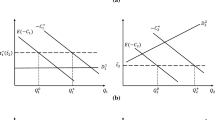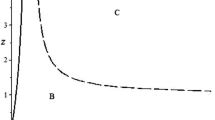Abstract
The idea of introducing “markets in licenses” to environmental quality control policy was first suggested with a rigorous economic foundation by Montgomery (JET: 1972; “Markets in Licenses and Efficient Pollution Control Programs”). This well-known classic paper considered regional environmental problems: There exist m industrial sources of pollution; each source emits a single pollutant affecting the environmental quality of several (n) locations; and the standard of environmental quality is chosen as a goal by a resource management agency. To develop decentralized systems for achieving environmental goals at multiple locations, Montgomery addressed two types of markets in licenses. One is the market in licenses to pollute, and the other is the market in emission licenses.
Montgomery’s study greatly contributed to the academic literature by offering a theoretical basis for subsequent emissions trading debates. On the other hand, the problem he considered was regional area-wide environmental problems, and thus his model setting seemed too general when used to address climate change. Some may even consider it obsolete.
However, when we step back to look at the challenges of climate change in a more general perspective, we must realize that Montgomery’s model is widely applicable to this issue.
The purpose of this study is to reconsider the relations between the two markets in licenses using the same framework as Montgomery, to show that his framework is still insightful. The emphasis is upon whether these two markets are compatible, and if so, in what conditions. These questions have never been answered by Montgomery’s original work. Although the result obtained here may seem abstract, it has important implications for future climate change policy debates, such as the post-Kyoto debates. It also suggests that current emissions market regimes, such as EU-ETS and the Kyoto mechanisms, may not be sufficient for the purpose of mitigating climate change, and that some additional technology policies are needed.
Similar content being viewed by others
References
IPCC. 2007. Climate Change 2007: Impacts, Adaptation and Vulnerability.Working Group II Contribution to the Fourth Assessment Report of the Intergovernmental Panel on Climate Change, Cambridge University Press.
Montgomery, D.W. 1972. “Markets in Licenses and Efficient Pollution Control Programs”, Journal of Economic Theory 5: 395–418.
Tietenberg, T.H. 2006. Emissions Trading: Principles and Practice, Second Edition, Resources for the Future, Washington, D.C.
Author information
Authors and Affiliations
Rights and permissions
About this article
Cite this article
Maeda, A. Markets in Licenses Revisited: Implications for Climate Policy. IJEPS 4, 203–224 (2009). https://doi.org/10.1007/BF03405723
Published:
Issue Date:
DOI: https://doi.org/10.1007/BF03405723




